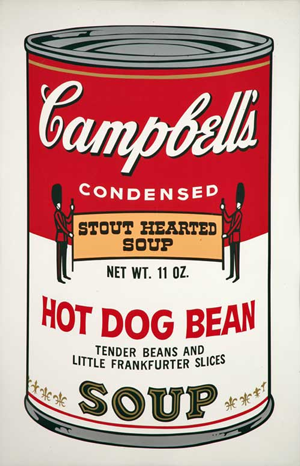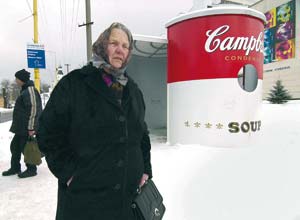Warhol's soup cans go home to Slovakia


The tranquil rolling hills of eastern Slovakia are an unlikely venue for one of the world's finest collections of pop art.
The quiet of a summer afternoon is broken only by the sound of peasants returning home from the fields, and the clip-clop of horses' hooves as they pull their owners' carts through this bucolic landscape.
Children stop from their play in the street to wave at rare passing cars, while old women, their walnut brown faces lined by decades of outdoor toil, stare suspiciously at new arrivals.
But despite its isolation, not far from the Ukrainian and Polish borders, the village of Medzilaborce has plenty of visitors: the thousands of tourists a year who make the trek through Ruthenia, as this part of Slovakia is known, to visit the Warhol Family Museum of Modern Art.
Today is the seventieth anniversary of the birth of Andy Warhol, the pop artist and seer who predicted that in the future everyone would have their fifteen minutes of fame. But his has lasted longer than a quarter of an hour and the Warhol museum in Medzilaborce aims to keep his work in the artistic limelight for posterity.
Two giant red and white renditions of Campbell soup cans, physical versions of Warhol's most famous prints, stand outside the museum's entrance. Towering over the museum are the white walls of the Orthodox monastery of St Spirit, for this is a deeply religious area. Warhol himself, until he died in February 1987, was a devout churchgoer.
Along with the publisher Robert Maxwell, who also came from this much contested part of Europe - alternately grabbed and ceded by Hungary, Czechoslovakia and the Soviet Union - Andy Warhol is probably Ruthenia's most famous son.
Although Warhol, real name Andrew Warhola, was born in Pennsylvania in August 1928, his family had its roots in the village of Mikova, not far from Medzilaborce.
But despite pride in itsRuthenian heritage and the family's commitment to the museum, it's a one-way love affair - museum officials dolefully admit that Warhol's rapid-fire repeating imagery and iconoclastic artwork are somewhat over the head of the locals.
"The people here don't understand pop art, to be honest. It's intriguing that such western art should be in such an eastern place, so only foreigners and art-lovers visit. It's true that our museum is isolated, but it needs to be here, because this was Andy Warhol's home region", said director Dr Michal Bycko.
Several authorities on Warhol believe that his religious faith - most Ruthenians follow eastern or Greek Catholic rites - influenced his work. His use of repeated colourful imagery, whether of Marilyn Monroe or Campbell's soup cans can be seen as a modern version of the iconography that is a hallmark of the eastern churches.
During the 1980s Warhol completed a series of paintings of eggs, based on a traditional Ruthenian design. Elaborately painting eggs with elaborate patterns, especially at Easter time, is still a strongly observed folk tradition in both Slovakia and its neighbours such as Ukraine.
Although the museum is subsidised by the Slovak Ministry of Culture, and there are plans to acquire 10 new original works by Andy Warhol, Dr Bycko says he fears a victory by the hard-line nationalist prime minister Vladimir Meciar in next month's Slovak elections.
Meciar's party, like several of its counterparts in the newly emergent nationalist states in eastern Europe such as Belarus and Croatia, seeks to keep a tight grip on the country's cultural life, shaping it according to a narrow, nationalistic political agenda.
For leaders such as Meciar, Slovak art is there either to be appropriated by the governing party, or should laud its supposed achievements - which does not include Pop Art.
"Cultural politics are terrible here. Before this government we had a very rich culture here. Now everything is defined by whether or not you are considered to be `pro-Slovak', which means pro-Meciar", said Dr Bycko.
"To say that art is something produced only by people such as Michaelangelo or Rembrandt is a dilettante's view of thinking. How long did it take until Van Gogh was considered a great artist, or even Picasso?"
But whatever the Slovak government's feelings about Andy Warhol, his family's strong attachment to its roots is evident in the museum. The site's exhibits, some unique in the world, include a record of his mother speaking and singing in the Ruthenian dialect, and several original family photographs and documents as well as many prints.
"The Warhol family artefacts are very important. The whole family kept a very strong connection with Slovakia, and even support the restoration of the local church", said Matt Wrbican, assistant archivist at the Andy Warhol Museum in Pittsburgh.
"Warhol himself was very devout, he worshipped at a church in Pittsburgh, and in New York he attended services several times a week. He is buried in a traditional cemetery."
As well as the permanent exhibitions, the museum also organises an art school for children sponsored by the Andy Warhol Foundation in New York. The museum's Factory Art Cafe is modelled on Warhol's own studio, also called Factory. Most important is the art, including original numbered screenprints such as the second print of Warhol's work "Ingrid Bergmann".
Source: The Independent, the 6 August 1998, by Adam LeBor
